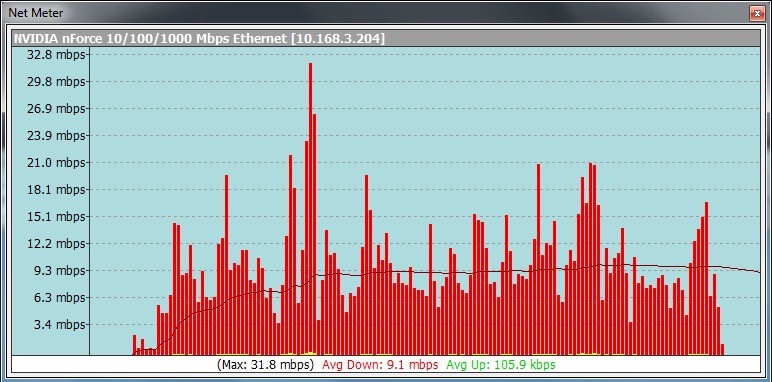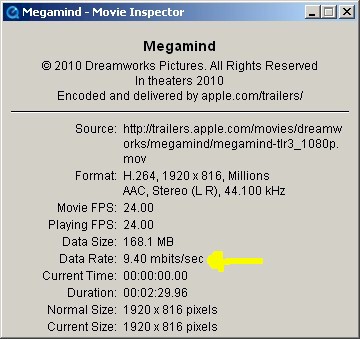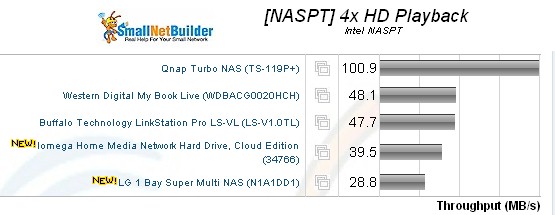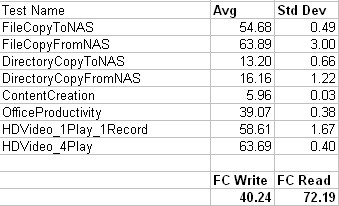Introduction
Most people want their NAS to be multi-purpose machines. And they usually want it to perform those multiple tasks at once.
The most critical tasks that NASes perform deal with real-time handling of data. Audio streaming, even with a household full of streams is no problem, since data rates are typically well below 1% (100 Kbps, give or take) of today’s even low-end NAS throughput.
1080p HD video streams are another matter. As the bandwidth profile of the 1080p Quicktime trailer In Figures 1 and 2 show, throughput constantly varies and can peak at 3 to 4 times the average throughput rate, with maximum rates in the 30 to 40 Mbps range.

Figure 1: Megamind 1080p trailer 3 bandwidth profile
But audio and video streams not only need a lot of bits moved per second, but that data has to be delivered exactly when it is needed, i.e. in real time. Computers don’t much care when copied bits get moved. But media players need the bits to arrive exactly on time.

Figure 2: Megamind 720p trailer 3 properties
This time-sensitivity can be lessened by the use of large and / or intelligent buffers, such as those built into the players that Netflix, Hulu and other Internet media services use. But for some reason, designers of most home media players think buffers are unnecessary, even though many buyers want to use those players via wireless connections, which can have higher throughput variation than some Internet streams.
However, even today’s low-end single-drive NASes have enough throughput to handle multiple HD streams. Figure 3 shows the NAS Chart results for four recent single-drive NASes. Even the lowest performing LG N1A1 at 29 MB/s (or 232 Mbps) has plenty of throughput to handle 4+ 720P HD streams.

Figure 3: Single drive NAS 4x HD Playback throughput
But we also know that streaming plays to a NAS’ key strength, reading or writing large sequential files. Assuming that the NAS drive wasn’t highly fragmented when the file was stored, playing back a video file involves minimal drive head seeking (moving from place to place across the drive platter), which is the biggest throughput killer.
The Test
So what happens when you have the NAS start moving that ol’ drive head around a lot? Can the NAS still get the HD stream bits out on schedule? I ran a few experiments to see.
I didn’t have any high-performance NASes on hand, so used the Synology DS109+ that is the backup for the QNAP TS-109 that’s my primary NAS. The DS109+ was new back in mid-2009 and dates from when Synology was still using Freescale CPUs. The 109+ uses a Freescale MPC8533 @ 1.06 GHz with 512 MB of RAM.
The test data I had for the 109+ predates my current test methods, so I ran the current test suite on it, which is summarized in Figure 4. The two year old DS109+ actually stacks up pretty well against the current-day NASes up there in Figure 3!

Figure 4: Synology DS109+ Benchmark Test Results
My tests were pretty simple and all conducted with Gigabit Ethernet connections. I played back 1080p Quicktime clips using VLC 1.1.8 on an Acer Aspire 1810T, which has HDMI out and plays both 720p and 1080p content nicely. I first played the clip from the Synology with nothing else accessing it to check that it played without problems.
I then played the clip while my Win 7 i3 based NAS Testbed machine was running the NASPT Content Creation and Office Productivity scripts to a folder on the Synology. These scripts—Content Creation in particular—always produce the lowest NAS Chart results. This is because they consist of mixes of reads and writes of mostly small file sizes, which move the drive head around a lot.
I was surprised to find, though, that the 109+ continued to stream without a hitch when the other scripts were running.
I then decided to step things up a bit and added another machine to the mix, running a large folder copy of mixed sizes to the Synology. I used my main Win XP SP3 Core 2 Duo machine over a Gigabit Ethernet connection. Again, the clip continued to play without a problem. I finally started a large folder copy on the same machine back from the Synology, while the copy to the Synology was still running, which again, had no effect on the HD streamed video.
Conclusion
While I can’t say that these tests represent the worst beating that can be inflicted on a NAS, they certainly represent a combination of tasks that buyers want to be sure their prospective NAS purchases can handle. And from what I can see, even inexpensive single-drive NASes can handle HD streaming mixed with significant file read / write activity without fear of video glitches.
